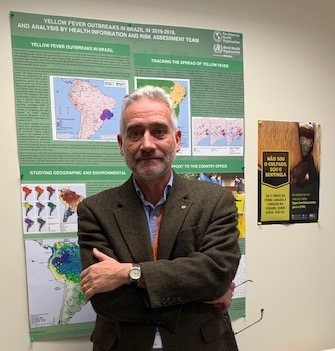PAHO/WHO Collaborating Centre Spotlight Series
Reference Number: USA-155
Official Title: PAHO/WHO CC for Viral Hemorrhagic Fevers
Institution: Viral Special Pathogens Branch (VSPB), Division of High Consequence Pathogens and Pathology (DHCPP), National Center for Emerging Zoonotic Infectious Diseases (NCEZID), Centers for Disease Control and Prevention (CDC)
Reference Number: USA-397
Official Title: PAHO/WHO CC for Bacterial Vector-Borne Diseases
Institution: Bacterial Diseases Branch, Division of vector Borne infectious Diseases, Centers for Diseases Control and Prevention (CDC)
Reference Number: USA-453
Official Title: PAHO/WHO CC for Global Health Security
Institution: Center for Health Security, Bloomberg School of Public Health, Johns Hopkins University
Category 5 (SP 14-19)
Outcome 23, 24 (SP 20-25)
Dr. Sylvain Aldighieri, Deputy Director, Health Emergencies, is the PAHO staff member who supports the WHO focal point to coordinate the collaboration between the institution and the Organization.
The main activities for these Centres include: (1) technical advice; (2) laboratory support; and (3) outbreak response.
Dr. Aldighieri notes that the Collaborating Centres that work with the Public Health Emergencies Department at PAHO assist the Organization with activities related to surveillance, infection prevention and control, and laboratory work. An example of this is the Collaborating Centre for influenza which is the regional reference centre with 28 national influenza centers (NICs) that support quality control and shipment of panels across the Region. Another example includes the deployment of teams from the Centre at CDC in Atlanta and from the Centre in Argentina (INEVH) in July 2015, in response to a new arena virus outbreak in Bolivia where samples were shipped to CDC and within weeks, CDC specialists were able to develop a polymerase chain reaction.
The Centre at the Viral Special Pathogens Branch, CDC utilizes serological, antigen-detection and molecular tests, viral isolation capacity and genetic sequencing capability to identify known or new viral pathogens. The Centre also supports outbreak response operations coordinated by WHO, related to emerging and dangerous pathogens by providing onsite laboratory diagnostic support with staff and equipment. Lastly, the Centre has supported the development of WHO recommendations, fact sheets and guidelines for outbreaks of Viral Haemorrhagic Fevers and novel and emerging infectious diseases.
The Centre at the Bacterial Diseases Branch, CDC has assisted with the development of a regional plan of action for plague particularly focused on Bolivia, Brazil, Ecuador, Peru, and the US, as surveillance of the plague requires lab work and technical advice for the characterization of strain type.
Currently there are no deliverables to report from the Centre at John Hopkins University.
Dr. Aldighieri notes “we cannot work in our job if we don’t work with PAHO/WHO Collaborating Centres.”
Webnotes such as these serve to inform how Collaborating Centres are contributing to the Organization’s priorities and mandates.


